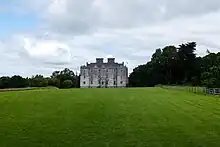The Earl of Clanricarde | |
|---|---|
| Born | John Smith Burke 11 November 1720 |
| Died | 21 April 1782 (aged 61) |
| Nationality | Irish |
| Alma mater | Winchester College |
| Spouse |
Hester Amelia Vincent
(m. 1740) |
| Children |
|
| Parents |
|
John Smith de Burgh, 11th Earl of Clanricarde FRS FSA (English: /dˈbɜːr/; d’-BER; English: /klænˈrɪkɑːrd/; klan-RIK-ard; né Burke, 11 November 1720 – 21 April 1782), styled Lord Dunkellin (/dʌnˈkɛlɪn/; dun-KELL-in) until 1726, was an Irish peer.
Career
The Honourable John Smith Burke was born to Michael Burke, 10th Earl of Clanricarde and his wife Anne Smith in 1720. He was the couple's fourth and last child, and the heir to the earldom, having two older sisters.
An older brother had died in infancy. He succeeded his father on the latter's death in 1726, at the age of six.
Lord Clanricarde was educated at Winchester College. He was elected a Fellow of the Royal Society and a Fellow of the Society of Antiquaries in 1753. He was a Privy Counsellor of Ireland for eight days in 1761, being struck off the list of the Council on 16 July.[1] He died in April 1782 at Portumna Castle, County Galway and was buried in the Dominican friary, Athenry.
Marriage and issue
In 1740, he married Hester Amelia Vincent, daughter of Sir Henry Vincent, 6th Baronet of Stoke d'Abernon. By Royal Licence on 13 May 1752, he and his uncles assumed the surname de Burgh which had been the family's surname in previous centuries: de Burgh was gaelicised in Irish as de Búrca which over the centuries became Búrc then Burke.[2][3]
The couple had four children:
- Lady Hester Amelia de Burgh, who married William Trenchard
- Lady Margaret Augusta de Burgh, wife of Luke Dillon (d.1825) of Hall Place, Warnford, Hampshire.[4] The couple's funeral hatchment survives in the Church of Our Lady, Warnford.[5]
- Henry de Burgh, 1st Marquess of Clanricarde
- General John Thomas de Burgh, 13th Earl of Clanricarde.
Honours and arms
- PC (Ire): Privy Counsellor, 1761
.png.webp) |
References
- ↑ "No. 10124". The London Gazette. 21–25 July 1761. p. 2.
- ↑ Cokayne, George Edward; Gibbs, Vicary (1910). The Complete Peerage of England, Scotland, Ireland, Great Britain and the United Kingdom. Vol. 3. London: George Bell and Sons. p. 235.
- ↑ Woulfe, Patrick (1923). Irish Names and Surnames (in English and Irish). Dublin: M. H. Gill & Sons Ltd.
- ↑ Cary's Itinerary, Hampshire 1815, pp.85-6
- ↑ see image[File:Gifts for sale within Our Lady, Warnford - geograph.org.uk - 1582284.jpg]
- ↑ Burke, John; Burke, Bernard (1844). Encyclopædia of Heraldry: Or General Armory of England, Scotland, and Ireland, Comprising a Registry of All Armorial Bearings from the Earliest to the Present Time, Including the Late Grants by the College of Arms. H. G. Bohn.
- ↑ Burke, Bernard (1884). The general armory of England, Scotland, Ireland, and Wales; comprising a registry of armorial bearings from the earliest to the present time. University of California Libraries. London : Harrison & sons.
Further reading
- Leigh Rayment's Peerage Pages
- Portumna Castle and its Lords, Michael Mac Mahon, 1983.
- Burke:People and Places, Eamon Bourke, Dublin, 1995.
- From Warlords to Landlords:Political and Social Change in Galway 1540–1640, Bernadette Cunningham, in "Galway:History and Society", 1996.
